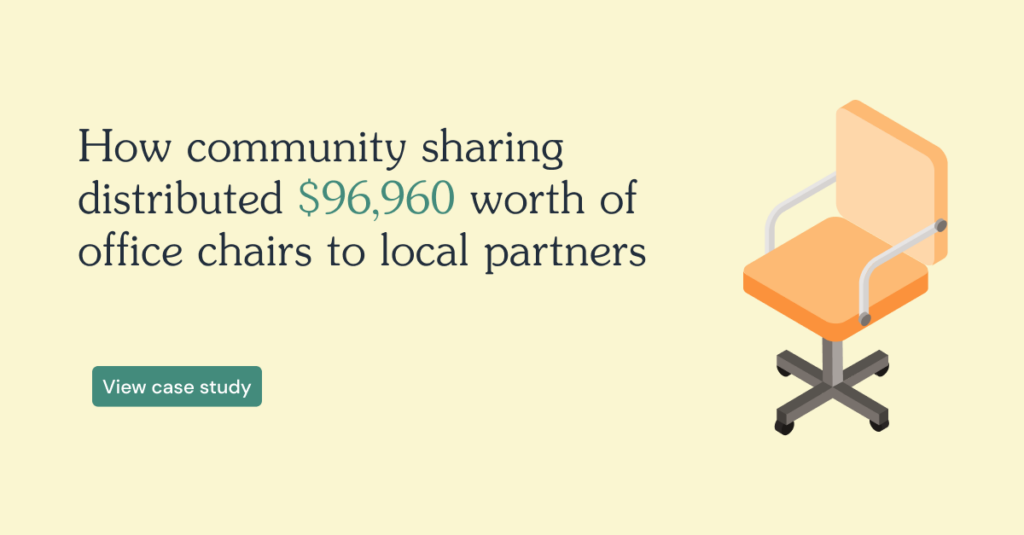Surplus Management
Rheaply puts reuse on the table for every organization.
Surplus management
One of the most critical aspects of running an organization that seeks to maintain financial stability and longevity is adequate surplus management. Surplus management generally refers to the process of identifying, analyzing, and managing the surplus assets of an organization. Surplus asset management may involve the effective utilization of resources in order to optimize financial returns and generate greater long-term value. For modern organizations seeking to ensure that they remain competitive and profitable in the long run, effective surplus management is vitally essential.
Managers and business leaders must work together to develop a sustainable surplus management process. By identifying and managing various surplus assets, organizations can reduce unnecessary expenses, decrease waste, and improve their overall financial health. Businesses can achieve these objectives by reallocating limited resources to areas that require more investment, such as research and development, employee training, marketing, and more.
Furthermore, surplus management can help organizations prepare for unforeseen circumstances. When a business maintains a sustainable surplus, they are generally better prepared to weather economic downturns or tumultuous geopolitical events without experiencing a significant financial setback. This is critical for businesses in volatile markets where fluctuations can rapidly erode profit margins.
However, developing a sustainable surplus management process is an ongoing process – not something businesses address once and once only. To ensure the organization remains on track to achieve its objectives, businesses must continuously monitor and analyze their operations and emphasize the importance of sustainability efforts. Additionally, surplus management is not merely about maximizing financial returns – it’s also about being responsible and sustainable members of their community. Organizations must find a balance between their financial objectives and their social and environmental responsibilities.
Top managers must develop a sustainable surplus management strategy that balances financial goals with social and environmental responsibilities to create long-term value, remain profitable in increasingly competitive marketplaces, and achieve other strategic goals.
Surplus management solution
A solid surplus management solution should have a clear list of steps that managers can follow to ensure that their organization is making the most of its available resources. Here are some key steps that business leaders can follow to develop an effective surplus management solution:
Step 1 – Identifying Surplus Assets
Firstly, businesses must identify all surplus assets within the organization. These assets may be physical, such as equipment, machinery, and inventory, or intangible, like intellectual properties and/or unused licenses. Managers must consider important factors like usage rates, maintenance expenses, and depreciation to determine which assets can truly be considered “surplus.”
Step 2 – Analyze Surplus Assets
Once all surplus assets have been identified, the next step is for businesses to analyze them thoroughly. This will likely involve an examination of their current usage rates, value and an assessment of their potential future use. Managers must consider other factors like market demand, the expected lifespan of the asset, as well as expenses related to ongoing maintenance and storage in order to determine if assets should be sold, repurposed, or otherwise disposed of.
Step 3 – Develop a Surplus Management Plan
Once surplus assets have been identified and analyzed, business leaders must develop a surplus management plan that outlines the appropriate steps to take for each unique asset. The plan should be comprehensive in its approach and include a timeline, a budget, and a list of responsible parties to ensure accountability. The plan must also outline the objectives of surplus management and how the business intends to achieve those specific objectives.
Step 4 – Plan Implementation
Putting a plan into action is oftentimes one of the most difficult parts of the process, but this step is vital to ensuring businesses can properly dispose of, repurpose, or sell surplus assets. Managers should also ensure that the parties responsible are able to fulfill their responsibilities effectively and must monitor progress to ensure that the plan stays on track.
Step 5 – Monitor Results
The final step in developing a robust surplus management solution is to monitor the results. This may involve measuring the success of the surplus management plan by comparing the actual results against the initial objectives and intended outcomes. Managers must consider factors like financial returns, reduction in costs, and environmental impacts to determine whether or not the surplus management plan has been executed successfully.
An effective surplus management solution involves a clear set of steps that managers can follow to optimize the use of the organization’s limited resources. Managers should identify the surplus assets, analyze them thoroughly, develop a surplus management plan, implement the plan, and finally, monitor the results.
Utilizing surplus management software can also help organizations automate many of these steps, which can help spare additional valuable resources. However, it’s crucial for business leaders to consider the cost and effectiveness of such software before deciding whether or not to implement it in the process.
With a successful surplus management solution process in place, organizations can optimize resources effectively, achieve strategic goals, and more effectively manage other assets and resources as well.

Surplus buying
Surplus buying typically refers to the common practice of purchasing excess materials, equipment, or assets that are not needed by an organization. This can result in wasted or unnecessary spending, increased storage costs, and environmental waste. To avoid surplus buying, procurement leaders, facility managers, supply chain leaders, and other senior executives must utilize sustainability management tools and implement an effective circular economy strategy.
One useful tool for businesses is sustainability exchange platforms. These platforms enable organizations to buy and sell surplus materials, equipment, assets, and more, which reduces the need to buy new items. Sustainability exchange platforms also promote greater collaboration between organizations by allowing them to share resources and collectively reduce waste.
Additionally, businesses are increasingly seeking to implement circular economy strategies within their operations. A circular economy is an economic system that focuses primarily on eliminating waste by reusing and recycling resources. By implementing a circular economy strategy, organizations can significantly reduce their reliance on buying new materials, equipment, and other assets.
To avoid surplus buying, procurement leaders and other senior executives may also want to consider implementing sustainability criteria into existing procurement processes. This could involve evaluating the environmental impact of the products and services that an organization purchases. By considering sustainability criteria, organizations can work with suppliers that align more closely with sustainability goals and reduce the strain on the environment and supply chains.
Moreover, organizations can implement waste reduction initiatives to avoid unnecessary surplus buying. These programs can include helpful practices like waste reduction, recycling, and even composting. By reducing waste, organizations can also reduce their environmental impact, save money on disposal expenses, and improve their brand prestige.
Surplus materials
Sustainable procurement refers to the process of businesses purchasing goods and services that have a less significant impact on the environment, respect for human rights, and the promotion of social and economic development. A sustainable procurement policy could help bring several advantages to businesses and organizations, including environmental, social, and economic benefits.
Too many surplus materials can cause headaches for organizations, both small and large. It can also lead to increased storage costs, reduced space, and decreased productivity as well. There are, however, a number of strategies that business leaders can utilize to get rid of surplus materials without throwing them away.
One common strategy for getting rid of surplus materials is selling business equipment. Businesses can achieve this by listing surplus equipment on online marketplaces or by contacting a specialized equipment reseller. There are numerous organizations that specialize in facilitating transactions between businesses or repurposing surplus materials to ensure that resources are allocated to where they’re needed most within a community.
Another strategy for getting rid of surplus materials is office furniture disposal. Because of its size, weight, and sheer volume, in some cases, office furniture can be difficult and expensive to dispose of. That said, there are still numerous options for disposing of office furniture in an environmentally friendly and cost-effective manner. For instance, some office furniture manufacturers offer buy-back programs where they will buy back their own furniture and dispose of it or refurbish it. Additionally, organizations can get in touch with local furniture recycling programs or donate their furniture to charitable organizations.
Procurement managers and other executives can also utilize a surplus property program to expel unwanted surplus materials. These programs are usually offered by government agencies and enable organizations to sell or transfer surplus materials to other organizations or individuals. This is a useful option for organizations that are interested in disposing of large volumes of surplus materials, equipment, or inventory.
In addition to selling or recycling surplus materials, businesses may also elect to donate them. Businesses can donate their surplus materials to charitable organizations, schools, community centers, and elsewhere. This can be a great way for organizations to give back to their local communities while simultaneously reducing waste and promoting sustainability efforts.
In conclusion, there are dozens of strategies that procurement managers and other business executives can utilize to get rid of or repurpose surplus materials without throwing them away. Selling business equipment, office furniture disposal, utilizing a surplus property program, or donating surplus materials – these are all effective and sustainable strategies. These efforts can help businesses reduce their environmental impact, lower expenses, and promote more sustainable business practices. And by adopting these techniques and strategies, businesses can effectively manage their surplus materials while achieving sustainability goals and improving brand perception.


